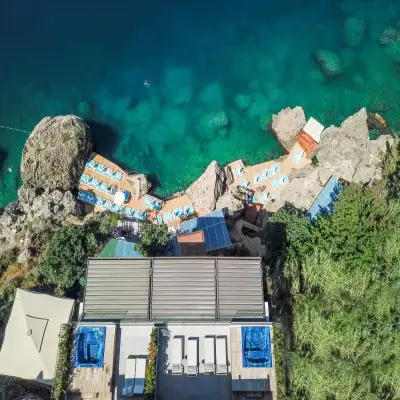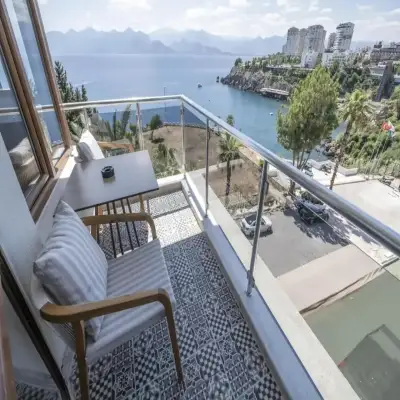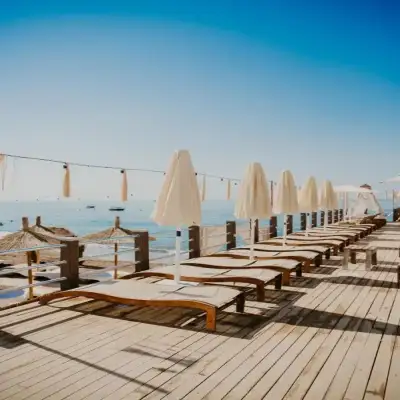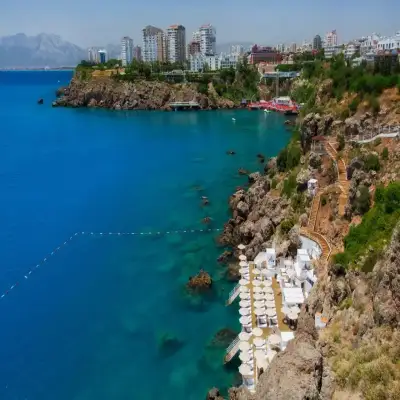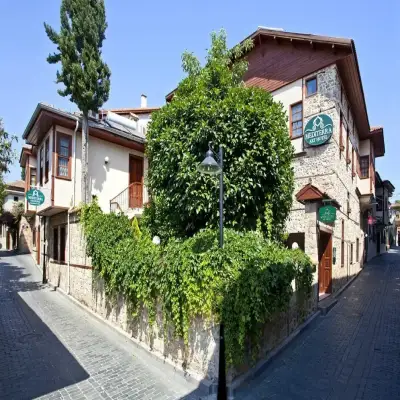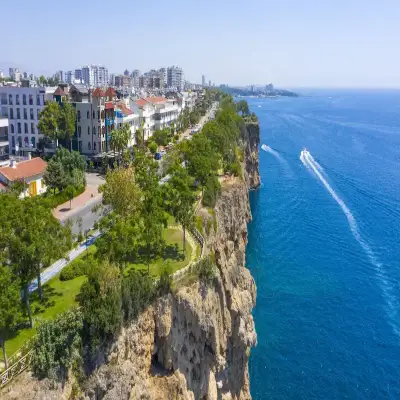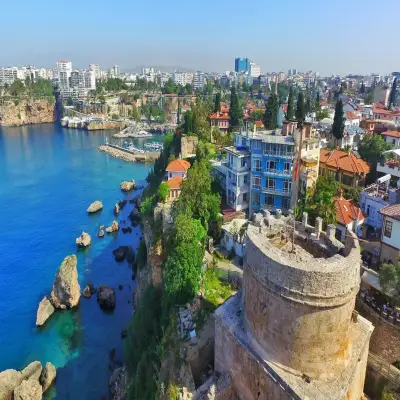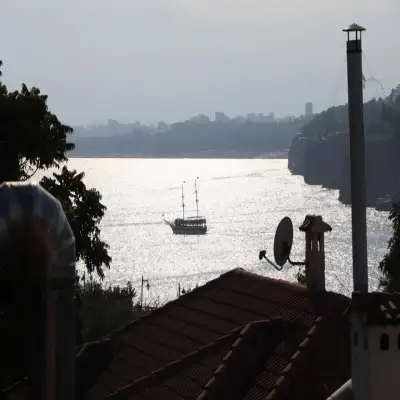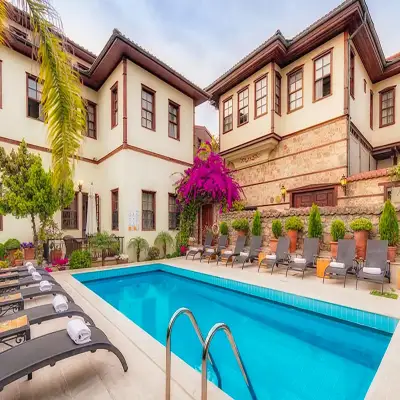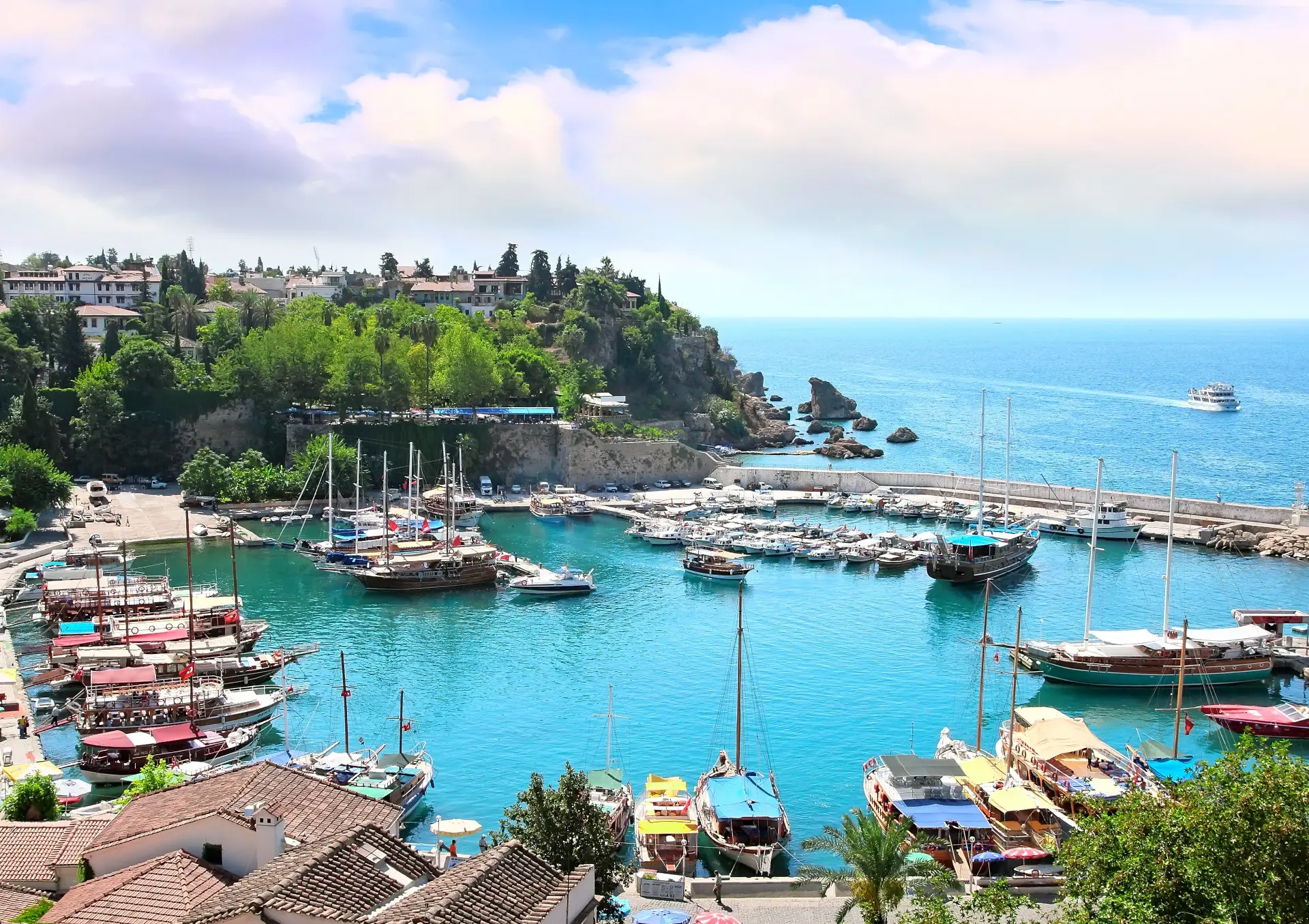
Antalya City Guide
Antalya, one of the first holiday centers that comes to mind when it comes to the Mediterranean, is one of the favorite places for all local and foreign holidaymakers. A place like paradise, where you can swim in the sparkling sea and sunbathe on that unique beach or climb to the top of the mountains, Antalya is a city that has watched the Mediterranean from the gulf waters, leaning its back against Beydağları, a city frequently mentioned in history.
The Arab traveler Ibn Battuta mentioned Antalya as follows:
“The people of the city settled in separate neighborhoods according to their race and religion. Christian merchants live in a neighborhood called Mina. Greeks live on their own in another neighborhood. Their neighborhood is also surrounded by a wall. The Jews also have their own neighborhood surrounded by a wall. As for the Muslim population, they live mainly in the big cities. These included a Friday mosque and a madrasah, many baths, and rich and well-organized bazaars. A large city wall surrounds the city, including all the neighborhoods mentioned above.” This is, of course, the Antalya of that period. Now Antalya is one of the exemplary cities of the south, united with tourism and culture.
In Antalya, you can come across both Ottoman and Roman traces in the same neighborhood. Especially Kaleiçi, where you can see these traces more often, can even be called the birthplace of Antalya. The courtyards of the houses, their architecture and the people on the streets reflect the culture of the town as it is. The narrow streets of Kaleiçi stretch from the harbor to the city walls on the hills. The old houses on these narrow streets tell you about the old Kaleiçi, the old Antalya. These old Kaleiçi houses are usually built of stone or wood. Almost all Kaleiçi houses have a garden inside. Old Kaleici houses with old bay windows will take you to other lands while walking through the narrow streets. We advise you to take lots of photos in these narrow streets.
There are many places and venues for sightseeing, dining and shopping in Kaleiçi. The Kesik Minaret or Kurşunlu and Duden Waterfalls and Karain Cave, Phaselis Ancient City, Aspendos Theater, Perge, Antalya Museum, Saklikent and Konyaaltı and Lara Beaches, Beycik Mountain and Village, Çıralı, Adrasan, Olympos, Demre, Kaş, Kalkan, Patara are the places you should visit. You should shop in the bazaar in the center of the town and taste delicious fish while sipping your drink against the sunset in the restaurants.
History of Antalya
The history of Antalya dates back to the stone age. The proof of this is the Paleolithic Age finds found in Karain Cave near Yağca Village. Karataş Semahöyük excavations yielded a large amount of Old Bronze Age finds. It is suggested by historians that the country of Ahiyava or Arzova mentioned in the cuneiform tablets of the Hittites could be Pamphylia (Antalya). However, except for a few finds except Side, there is no evidence that he lived here. In Greek legends, it is written that after the Trojan War, some Achaean clans reached Pamphylia under the direction of Kalkhas. The origin of the Lydians who settled within the borders of Antalya is not known for certain. In Hittite and Egyptian sources, it is possible that a tribe called Lükki or Lükka in 2000 BC were Lydians. This tribe was mentioned for the first time during the reign of King Croissos of Lydia. The Antalya region was once under the Lydian kingdom. With the defeat of King Kroissos to the Persian King Kyros, 546 BC, Persians dominated this region until Alexander. In 334 BC, Alexander, King of Macedonia, marched to Pamphylia through Lydia and captured the cities here except Silyon. The city of Termesos in Psidia resisted Alexander by not surrendering. After the Apemeian peace in 188 BC, the Romans left this region to the Kingdom of Pergamon.
Pergamon King Aktalos II founded Antalya as a port city in 159-138 BC. In 102 BC, when a province called Klikya was established in Anatolia, it was connected to this province and in 36 BC, Anteunus gave Pamphylia to Amyntas, King of Galatia. Emperor Claudius made Pamphylia and Lycia a state in 43 AD. Antalya region experienced its most glorious periods from the 2nd century A.D. to the middle of the 3rd century.
Antalya region was taken by the Anatolian Seljuks during the reign of Suleiman Shah, but Antalya was left to the Byzantines with the treaty made in 1117.
The second settlement in Antalya took place during the reign of Gıyaseddin Keyhüsrev I in 1206 and Ertokuş Bey was appointed as the Subashi. During the reign of this ruler (1204- 1215), Trabzon - Iznik Greek Imp. and the inhabitants of Antalya were closed to the Seljuks. When Gıyaseddin I was killed, Christians united with Cyprus and took Antalya back. But three days later, it was captured by İzzettin Keyhüsrev I and connected to the Seljuks.
After 1336, with the withdrawal of the Mongols, the period of principalities began in Anatolia. Antalya was monopolized by Tekelioğulları, a branch of the Hamitoğulları Principality. During the reign of Yıldırım Beyazıt, Antalya came under Ottoman rule and was given to Firuz Bey in 1391. Antalya is now known as Teke Sanjak. Today's Antalya, which is Turkey's gateway to the world in tourism, has a Kaleiçi, which is based on the 2nd century BC Attaleia and an even earlier settlement whose name is unknown. At the northeastern end, where the Hellenistic-Roman walls, which surrounded the city on three sides until recently, are opened to give passage to the city, it is entered by a three-arched Hadrian's gate built in honor of the emperor's arrival to the city in 1300 AD.
Historical and Touristic Towns to See in Antalya
ASPENDOS: Its history dates back to the 5th century BC. Founded in the 2nd century AD, the theater was periodically repaired by the Seljuks and used as a caravanserai. It is one of the rare theaters that has managed to be preserved until today. With a distance of 0.50 meters between the seats, it has an audience capacity of 7000 people and an orchestra capacity of 500 people. Today, Aspendos is actively used for many concerts, festivals and oil wrestling competitions.
TERMESSOS: Termessos is perhaps the most interesting ancient city in the Antalya region. It was built at an altitude of 1050 meters in the Taurus Mountains. Termessos has a rich collection of rare plant and animal species, which are now protected in the Termessos National Park. The inhabitants of the area were known as Solyms, and unlike other cities, they did not come from the sea, they were all from Anatolia.
The most important event in their history was in 333 BC when Alexander the Great besieged the city, which he likened to an eagle's nest, and failed to conquer it. Termessos then suffered a great decline and was abandoned in the 5th century AD.
PHASELIS Phaselis, known to have been founded as a port city by the Rhodians in 693 BC, has three harbors. The ancient harbor you come across at the entrance is called the northern harbor. Right next to it and to the right is the small middle harbor and at the end of the harbor street is the south harbor. The whole city is covered with pine trees. Therefore, you can easily walk around even in the hot days of summer.
The city walls that surround the city from the sea and were built to protect against pirate attacks, the aqueducts that you will encounter right at the entrance, the harbor street connecting the central and southern harbor, Hadrian's gate at the entrance of the southern harbor of the street, the theater on the sea side of the street, the acropolis on the hill and the agora next to the southern harbor are among the places worth seeing.
MYRA (DEMRE): Myra was one of the most important cities among the other six Lycian cities. It was founded in the 5th century BC. Myra, which was a coastal city at first, was filled with alluvium from the Demre stream. It was invaded by the Arabs in the 9th century AD. The rock cemeteries, the theater and the Church of St. Nicholas have managed to survive and make this region a valuable town to visit.
ST.NICHOLAS: St. Nicholas was born in Patara near Fethiye in 245 AD and died in 363 AD after spending his life in Anatolia. Born into a wealthy family and well educated, he devoted himself to humanity. He was known as the protector of children and sailors and this legend has survived to this day. After his death, he was buried in Demre and a church was built in his memory. In 108, Italian pirates stole some of his bones and took them to Bari. In their haste, they left some bone fragments there and these bones are now exhibited in the Antalya Museum. In many countries, the death of St. Nicholas is commemorated by giving gifts to children and this commemoration ceremony has gained meaning in the New Year.
ROCK TOMBS The Myra region has some of the most impressive and well-preserved Lycian ruins in the whole of Turkey. These include an excellent collection of rock tombs and a theater dating from the second century.
Many of the tombs have wood carved into the rocks, reflecting the domestic architecture of the time. Some of the more accessible tombs have inscriptions in Lycian. The upper tombs have not been restored, but the complexity of this architecture with its theme of death is quite impressive.
KEKOVA THE TIE-DYED CITY: As trade between the Lycians and Hellenistic Greeks increased, so did piracy and the fortification of many ports. Kekova was one of these harbors. While traveling by boat you will see the walls and ruins of buildings in the sunken city. You will stop a few times to swim and snorkel, but beware of the sea urchins. Diving near the sunken buildings is forbidden, as is picking up any old-looking stone or historical artifact. You will regret not taking your snorkel and mask, your captain will definitely show you where you can dive.
OLIMPOS: Olympos is like an Indiana Jones location combined with a beautiful beach and a perfect view. Located in the middle of a national park, Olympos is covered in breeze currents from the surrounding mountains. The area, which has not been extensively archaeologically excavated, is covered by a sparse forest.
Thanks to this forest, the atmosphere is full of unexploredness and secrecy. Due to the location of Olympus, it is very pleasant to sunbathe and swim while visiting the historical ruins. The city is dedicated to Hephaestus, the God of Power, and it is believed that his presence adds power to the eternal flames of Chimera (Yanartaş) on the other side of the mountain.
Olympos forms part of the Olympos-Bey Mountains National Park in the city of Antalya, which covers the southern coast of Turkey. The Bey Mountains are located on the western flank of the Taurus mountain range. As you descend from its snowy peaks, you can see the turquoise color of the Mediterranean Sea through the lush pine and cedar trees.
Since Olympos is an archaeological site, it is prevented by law from becoming a major tourist center. Thus, the natural structure of the region has been preserved and Olympos has become a unique natural paradise where all visitors have a pleasant time. The ancient city was finally conquered by nature. To visit the city, you need to make an adventurous journey through the forest, seeing wildlife and smelling the scent of pine and laurel trees. The magnificent coastline is not only home to sunbathing enthusiasts. In the summer months, large sea turtles come to Olympos-Çıralı beach to lay their eggs at night. Witnessing this event is not an experience that everyone will have. If you are ever in Olympos, don't forget to watch the turtles.
History of Olympus It is believed that the word “Olympus” means “great mountain” in ancient Greek. More than twenty mountains and hills around the world bear this name, and some of them have towns and cities near them. The most famous of these hills is the Thessalian Hill in northeastern Greece, home of the ancient Greek gods. The ancient city of Olympos takes its name from Mount Tahtalı, formerly known as Mount Olympos. Mount Tahtalı is located 10 km. north of the city and its foothills are home to the never-extinguishing fire known today as Yanartaş.
Olympos was one of the most important cities of the ancient Lycian civilization. The foundations of the city were built in the ancient Hellenistic period, around 300 BC. It is known that Alexander the Great spent the winter months in Phaselis, a port city neighboring Olympos, when he first started his conquests.
The first trace of Olympos in historical records is found in 78 BC, when Servilius Vatia, the Roman Governor in Sicily, defeated Zenicetes, the greatest pirate of the time, in a naval battle. Zenicetes, who hid his ships in the secret harbors of Porto Genoa and Sazak, took control of the entire coastline and made Olympos his fortress. After the city fell back under Roman rule, it was declared “ager publicus” (Roman property for sale or rent).
The pirates are said to have organized strange sacrifices and secret rites for the Persian god Mitras. Mitras is the god of pure spirit and light in Persian mythology, which was widely believed in many eastern countries at the time.
In 43 AD, Lycia joined the Roman Empire. Festivals were organized for the Greek God Hephaistos, the protector of the city of Olympus. It is also recorded that Emperor Hadrian visited the city in 130 AD.
Olympos was home to a bishop when the Roman Empire was in the process of Christianization. From the 3rd century onwards, the population of the city gradually decreased as a result of the constant attacks of pirates on the city and the city lost its former importance.
In the 11th and 12th centuries, the city was rebuilt by the Genoese, Venetians and Knights of Rhodes and used as a trading port during the crusades. The city of Olympos was abandoned in the 15th century when the Ottoman Navy took control of the eastern Mediterranean.
YANARTAŞ-ÇIRALI Yanartaş/Chimera is a mountain of legends as you climb the burning rocks. Ignited by the gas leaking from underground, Yanartaş is the cradle of many legends in Çıralı. When the flame-spewing Khimaira terrorized Lycia, Bellerophon jumped on his winged horse Pegasus and ran to punish the monster, and erected an altar for his goddess Athena in memory of his killing, but he could not extinguish the flames. This is the story of the stones that have been burning for 4000 years. Olympos Olympos, once one of the most important port cities of Lycia, is now a sad city surrounded by laurel trees.
One of the most natural and untouched virgin beaches of the Mediterranean is in ÇIRALI. In front of you is the most beautiful blue of the sea and behind you is Tahtalı Mountain, which resembles a unique tropical forest. The end of the beach is the ancient Lycian ruins of Olympos. Hidden in the forest covered with vines where the stream meets the sea, a mystery to be discovered scattered on both sides of the stream. You can reach it in about 5 minutes on foot.
The indomitable fire Chimaera is on the upper side of Çıralı “lion on the front, snake on the back, goat in the middle”. Chimaera suffers the defeat of the valiant Bellerophontes who fights on the winged horse Pegasus on this mountain. He disappeared from the earth, spewing flames from his mouth, which resembled a volcano crater, but his flames remained on the rocks. Now it burns in summer and winter without ever going out.
For accommodation suggestions, you can check our Antalya Center Hotels page.



